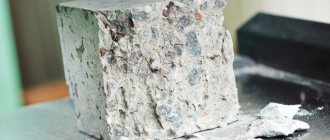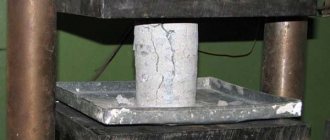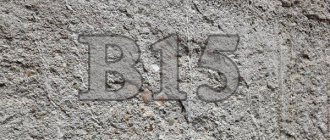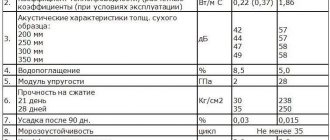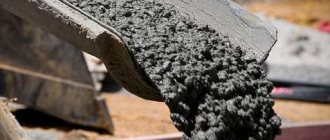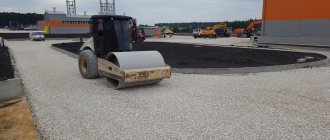GOST 18105-2010
INTERSTATE STANDARD CONCRETE Rules for monitoring and assessing the strength of Concretes. Rules for control and assessment of strength
ISS 91.100.30
Date of introduction 2012-09-01
Preface
The goals, basic principles and basic procedure for work on interstate standardization are established by GOST 1.0-92 “Interstate standardization system. Basic provisions" and MSN 1.01-01-2009 "System of interstate regulatory documents in construction. Basic provisions".
Standard information
1 DEVELOPED by the Research, Design and Technological Institute of Concrete and Reinforced Concrete (NIIZhB - branch of the Federal State Unitary Enterprise "SRC Construction")
2 INTRODUCED by the Technical Committee for Standardization TC 465 “Construction”
3 ADOPTED by the Interstate Scientific and Technical Commission for Standardization, Technical Regulation and Certification in Construction (Appendix D to Protocol No. 37 of October 7, 2010)
The following voted for the adoption of the standard:
| Short name of the country according to MK (ISO 3166) 004-97 | Country code according to MK (ISO 3166) 004-97 | Abbreviated name of the national construction management body |
| Azerbaijan | AZ | Gosstroy |
| Armenia | A.M. | Ministry of Urban Development |
| Kazakhstan | KZ | Agency for Construction and Housing and Communal Services |
| Kyrgyzstan | KG | Gosstroy |
| Moldova | M.D. | Ministry of Construction and Regional Development |
| Russian Federation | RU | Department for regulation of urban planning activities of the Ministry of Regional Development |
| Tajikistan | T.J. | Agency for Construction and Architecture under the Government |
| Uzbekistan | UZ | Gosarchitectstroy |
| Ukraine | U.A. | Ministry of Regional Development and Construction |
4 This standard takes into account the main regulatory provisions of the European standard EN 206-1:2000 “Concrete - Part 1: General technical requirements, performance characteristics, production and compliance criteria” (EN 206-1:2000 “Concrete - Part 1: Specification, performance , production and conformity") in terms of monitoring and assessing the strength of concrete.
Level of conformance - nonequivalent (NEQ)
5 By Order of the Federal Agency for Technical Regulation and Metrology dated March 21, 2012 N 28-st, the interstate standard GOST 18105-2010 was put into effect as a national standard of the Russian Federation on September 1, 2012.
6 INSTEAD GOST 18105-86*
________________* In the Russian Federation, until September 1, 2012, GOST R 53231-2008 is in force.
Information on the entry into force (termination) of this standard and amendments to it is published in the “National Standards” index.
Information about changes to this standard is published in the index (catalog) “National Standards”, and the text of the changes is published in the information indexes “National Standards”. In case of revision or cancellation of this standard, the relevant information will be published in the information index “National Standards”
Appendix A (mandatory). Selection of a single value of concrete strength for non-destructive testing
The unit value of concrete strength during non-destructive testing is taken to be:
- when inspecting prefabricated structures (flat and hollow-core slabs and coverings, road slabs, panels of internal load-bearing walls, wall blocks, as well as pressure and free-flow pipes) - the average strength of the concrete of the structure, calculated as the arithmetic mean value of the strength of the concrete of the controlled sections of the structure;
- when monitoring other types of structures - the average strength of the concrete of the structure or the controlled section or zone of the structure, or part of a monolithic and prefabricated monolithic structure.
Key words: concrete, rules for monitoring and assessing strength, uniformity of concrete strength, acceptance of concrete strength
Helpful information:
The compressive strength of concrete is the main indicator that characterizes concrete. Currently, there are two systems for expressing this indicator, namely:
Concrete class, B
- this is the so-called cubic strength (i.e. a compressible sample in the shape of a cube) showing the withstand pressure in MPa, with a probability of failure of no more than 5 units out of 100 tested samples. It is designated by the Latin letter B and a number indicating the strength in MPa. According to SNiP 2.03.01-84 “Concrete and reinforced concrete structures”.
Concrete grade, M
is the compressive strength of concrete, kgf/cm2. It is designated by the Latin letter M and numbers from 50 to 1000. The maximum permissible deviation in concrete strength is 13.5%. According to GOST 26633-91 “Heavy and fine-grained concrete. Technical Specifications" establishes the following correspondence between the concrete grade and its class.
Compliance of concrete grade (M) with class (B) and compressive strength
Concrete grade, M
Concrete class, B
Strength, MPa
Strength, kg/cm 2
Determination of Brand and Class of Concrete
The concrete grade and class are determined 28 days from the date of pouring, under normal conditions, or the calculation is carried out taking into account the coefficient.
Determination of the Shore strength of concrete using a sclerometer (Schmidt hammer)
One of the most common and effective ways to quickly measure the compressive strength of concrete or its grade is to measure it with a sclerometer, or as it is also called, a Schmidt hammer. Control of concrete strength by this method is determined according to GOST 22690-88 “Concrete strength determination by mechanical methods of non-destructive testing”. The so-called Shore hardness measurement method using the rebound method.
The operating principle of the Schmidt hammer is based on measuring the strength of concrete using the elastic rebound method. The firing pin hits the concrete surface and bounces off. The striker sets the pointer on the sclerometer scale to the maximum rebound height. Thus, after taking several samples, the average indicator is calculated, which determines the grade of concrete.
Unfortunately, this method does not give accurate readings since the rebound height of the striker is influenced by other factors such as surface roughness, thickness of the test sample, methods of concrete compaction when pouring it, and, accordingly, its general structure and other factors. So an error in the readings of a scleroscope (sclerometer) is almost inevitable, but, fortunately, it is very small.
The approximate correspondence of the height of elastic rebound according to the Schmidt hammer scale (sclerometer) to the class of concrete (B) and its grade (M) is given in the following table:
How to determine the strength of ready-mixed concrete
There are several ways to diagnose the strength characteristics of a concrete structure. The most common definition of strength is the method of chipping. But there are other ways:
- Non-destructive testing using special devices.
- Method of local destruction.
- With the impact method, impact energy is recorded when the equipment and surface come into contact.
- Ultrasonic method using a wave sensor.
- Destructive methods involving the removal of fragments from a concrete structure.
What factors affect the strength of concrete?
The strength of the concrete mixture depends on the water-cement ratio. The most common ratio used in practice: 0.3:0.5. With a lower value, the solution will acquire low plasticity; with a larger value, the mobility will improve, but the strength will decrease. The quality of a cement-based concrete mixture depends not only on the incoming components, but also on their ratio.
Composition of concrete by grade and class table
Attention! The more cement contained in the concrete mixture, the higher the grade and strength of the concrete structure.
Setting the fill
The setting time of concrete is:
- in hot summer - no more than an hour: the process begins 2 hours after preparing the solution;
- in cool weather - more than a day: the concrete will begin to set 6-10 hours after preparing the mixture, and the whole process can take 20 hours (after pouring).
Any temperature fluctuation - cooling or warming - is reflected in the process of concrete setting.
How does concrete gain strength at different air humidity levels? If the weather is dry, the poured solution dries out quickly, and the rate of addition decreases sharply. The complete absence of moisture causes hardening to stop.
Maximum humidity combined with high temperature significantly accelerates the strength gain of the material.
Class and grade of concrete
The main indicator by which the class and grade of concrete is determined is the compressive strength. Moreover, the guaranteed strength with a permissible error of 13.5% (the so-called coefficient of variation) is reflected by the class of the material; the grade is necessary to indicate the average strength value.
According to SNiP 2.03.01-84, the first indicator is measured in megapascals (MPa) and is designated by the letter “B” of the Latin alphabet. For example, the designation “B25” says that the material can withstand pressure of 25 MPa in 95% of cases. The full range of B is from 3.5 to 80, with the main range including B values of 7.5-B40. The strength of concrete is specified by the “M” grade and numbers ranging from 50-1000, reflecting the average compressive strength (measured in kgf/cm²). The main range includes compositions M100-M500.
What does the class of concrete depend on?
- cement content . The higher the cement content in the mixture, the higher the strength of the final product;
- cement activity . Higher strength cements produce more reliable structures.
- water cement ratio . As the W/C ratio decreases, strength increases. This is explained by the structure of the composition: excess water contributes to the formation of excess pores in concrete, which worsen its technical characteristics.
- quality of aggregates . The use of fine-grained fillers, fine dust fractions, clay, and organic impurities contributes to a decrease in the strength of the composition.
- the degree of compaction of the concrete mass and the quality of its mixing. The performance characteristics of the composition can be increased using turbo and vibration mixing and compaction of the mixture.
Table of the ratio of classes and grades of concrete
As the compressive strength grade of concrete increases, the tensile strength increases, but the increase in tensile strength becomes less significant in the area of high-strength types. The tensile strength of the material is 1:10 - 1:17 to the ultimate compressive strength, while the flexural strength is 1:6 - 1:10.
The maximum permissible strength threshold of the composition is individual for each brand.
Compositions with higher M values have the lowest critical strength. Critical indicators are reached on the first day after pouring the mixture.
Control samples
Compressive strength is tested in laboratories using manufactured samples in accordance with GOST requirements. However, you can check the brand compliance yourself at the construction site.
To do this you need:
- prepare wooden molds with internal edge dimensions of 100x100x100 mm;
- take a sample of the concrete mixture from the mixer tray and pour several cubes into pre-prepared molds;
- compact the composition by pinching it in several places or by hitting the shape with a hammer. This measure allows you to eliminate air bubbles formed in the mixture;
- keep the resulting cubes at a humidity of 90% and a temperature of +20°C, excluding direct exposure to the sun’s rays;
- after 28 days, transfer concrete samples to the laboratory for examination. It is possible to submit some samples at intermediate stages of solidification (on the 3rd, 7th and 14th days) for preliminary examination.
Carrying out these activities will allow you to determine whether the brand and class of concrete that was brought to the construction site corresponds to what you ordered.
Waterproof
Water entering microcracks in a concrete structure can lead to significant damage during subsequent freezing. Water resistance is measured by the level of one-way hydrostatic pressure (kgf/cm²), when the sample does not allow moisture to pass through.
Seals and hydrophobic additives can improve water resistance. The cost of a concrete mixture with high water resistance is significantly higher. But a concrete structure made from such a mixture does not need waterproofing and will last longer. It is from waterproof material that pedestrian paths, concrete fortifications, curbs and other objects that are constantly exposed to the external environment are made.
The moisture resistance of the material is determined by the water-cement ratio in the composition and the filtration coefficient. According to GOST, there are 10 levels of water resistance: W2, W4, W6, W8, W10, W12, W16, W14, W18, W20. Impermeability means that a concrete sample 15 cm high will withstand a certain maximum water pressure under standard conditions.
Depending on moisture permeability, the concrete mixture is classified into three categories:
- “N” – normal moisture resistance W2-W4;
- “P” - reduced permeability W4-W6;
- “O” – particularly low moisture permeability W8 – W20.
The most resistant to water is the W20 brand. However, due to the high cost, W10-W20 is used only on fundamental construction sites: the construction of bunkers, hydraulic facilities, and reservoirs. These types have another important quality: frost resistance.
Producing high-quality waterproof concrete
For this purpose the following methods are used:
- High-strength cement M600-M1000 is used, which, when hydrated, absorbs water much more than other types of cement. As a result, a dense stone-like mass is formed;
- Air-entraining fillers are added to the concrete mixture: aluminum or iron sulfates, which increase the compaction of the material during laying;
- plasticizers are used to reduce the water-cement ratio;
- Waterproofing components are added to the concrete mixture.
Frost resistance
The packaging of the material is marked with appropriate markings indicating the degree of frost resistance. This property is determined by the number of freezing/thawing cycles during which the material is deformed. A sample of the material is immersed in water or a special solution, kept there until completely absorbed, then frozen to -18 degrees. Periodically measure how much strength the material has lost. After completing a number of cycles, the frost resistance index is determined.
Frost resistance marking
According to GOST, frost resistance is marked as follows: F50, F100, F150, F200, F300, and these grades are grouped according to the following scheme:
- Less than F50: low level of frost resistance, used extremely rarely.
- F50 - F100: moderate, widely used in construction.
- F150, F200: increased frost resistance, withstands strong temperature changes.
- F300 - F500: high frost resistance, used in particularly difficult conditions.
- Above F500: increased frost resistance, used in rare cases. High-quality cement is used in the mixture and special substances are added.
